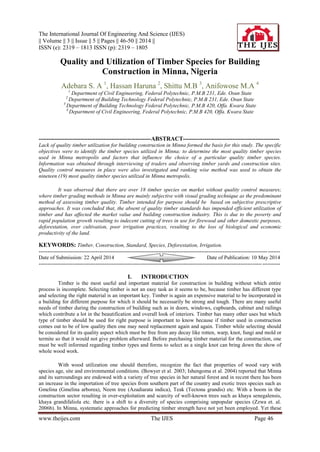The document discusses the quality and utilization of timber species for building construction in Minna, Nigeria, highlighting the lack of quality standards and control measures. It identifies over 18 timber species in the market, with a reliance on subjective grading methods, leading to potential structural issues in construction. The study concludes that poverty, rapid population growth, and environmental factors contribute to deforestation and the scarcity of quality timber, necessitating improved management strategies.




![Quality and Utilization of Timber Species for Building Construction in Minna, Nigeria
www.theijes.com The IJES Page 50
IV. CONCLUSION
The chances of timber engineering and the use of timber as load-bearing material depend on the quality
criteria. The most important factor is the economical use of timber in order to increase its utilization in
construction and make it competitive in comparison to other constructional materials. Timber as a material for
supporting systems is an indicative orientation for the use of wood in further constructions. Therefore, all kinds
of wood and timber, from round wood to squared timber through composite sections made of boards and
squared timber, as well as glue-laminated timber, plywood, etc., especially when combined with other materials,
must be developed and employed. In order to take advantage of better qualities, one needs only to build in the
best pieces of timber in the most solicited construction elements. This requires the admission of non-destructive
testing equipment’s which can, like the Sylva test ultrasound method, determine single resistances much more
precisely; this goes for the elasticity modulus as well as for the modulus of rupture.
The study shows that there are limited numbers of quality timber species in Minna. Timber grading
methods in Minna are mainly subjective with visual grading technique as the predominant method of assessing
timber quality. Timber intended for purpose is based on subjective prescriptive approaches. The study also
revealed that due to the poverty and rapid population growth it lead to extension of farmland, overgrazing, bush
burning, cutting of trees to use for firewood and other domestic purposes, deforestation, over cultivation, poor
irrigation practices, inappropriate land use by the rural dwellers and these result to loss of biological and
economic productivity of the land. Therefore, there is need for Federal government to strengthen the capacity of
state government institutions and involvement of local people in collective decision making for effective
management of grazing land and trees as common pool resources. An initiative of poverty reduction strategies
with aim of diversification among the rural dwellers to reduce pressures on the dry land should be encouraged.
Equally, more effort to fuse agencies like National policy on the Environment 1999 under the supervision of
Federal Environmental Protection Agency (FEPA), National Environmental Standard and Regulations
Enforcement Agencies (NESREA) to combat desertification should be carried out.
REFERENCES
[1] Bowyer, J. L., Shmulsky, R. And Haygreen J. G. (2003). An Introduction. Forest Products and Wood Science. Fourth Edition.
Iowa State Press.
[2] Erfurth, T. (1976) Product Development And The Choice And Effective Application Of Promotional Measures To Advance
The Wider Use Of Products From The Tropical Moist Forest. Fao, Rome.
[3] Erfurth, T. And Rusche H. (1976) The Marketing Of Tropical Wood. Fao. Rome.
[4] Ishengoma R. C., Gillah, P. R., Amartey S. A. And Kitojo D. H. (2004). Physical, Mechanical and Natural Decay
Resistance Properties Of Lesser Known And Lesser Utilized Diospyros Mespiliformis, Tyrachylobium Verrucosum And
Newtonia Paucijuga Timber Species From Tanzania. Holz Als Roh- Und Werkstoff Springer Berlin/Heidelberg. Issue:
Volume 62, Number 5; 387–389.
[5] Ishengoma, R.C., Gillah, P.R. And Kimu, M. M. (1994). Properties Of Juvenile And Mature Wood Of Cupressus
Lusitanica Grown In Kawetire Forest Plantation, Mbeya- Tanzania. East African Agriculture And Forestry Journal. (1994) 59(4),
287–292. Kityo, P.W.
[6] Leicester, R.H. (2001). Engineered Durability For Timber Construction. Progress In Structural Engineering & Materials. Vol. 3
(3):216–227.
[7] Leicester, R.H. (2002). Future Directions Of Timber Engineering Research. CSIRO Division Of Building, Construction
And Engineering. NZ Timber Design Journal. Issue 4
[8] Mackenzie R. K. T., Smith R,.S. And Fairfield, C.A. (2005). New Directions For NDT In Forestry.British Institute Of Non-
Destructive Testing.
[9] Natterer, J., Herzog, Th., Volz, M., (1991): Holzbauatlas Zwei. Hrsg.Arbeitsgemeinschaft Holze.V. und Inst. f. int.
Architektur-Dokumentation. D-München. OE Nov 21, 1996
[10] Odokonyero, G. G. 0. (2005). Forest harvesting case study; pit sawn timber production in natural forests of Uganda.FAO
Publication.
[11] Towler, R.W. (1975). The Possibilities Of Increased Consumption Of The Lesser Known Tropical Hardwood Species.
Commonwealth Forestry Review. Vol. 54(3) And (4), Nos.161 And 162.
[12] Winandy J. E. (2002). Emerging Materials: What Will Durable Materials Look Like in 2020?
[13] Zziwa, A. Kizito, S. Banana, A. Y., Kaboggoza, J. R. S., Kambugu, R. K. and Sseremba O. E. (2006a). Production of
composite bricks from sawdust using Portland cement as a binder. Uganda Journal of Agricultural Sciences, 12(1): 38–44 ISSN
1026-0919.
[14] Zziwa, A., Bukenya, M., Sseremba, O. E. and Kyeyune, R.K. (2006b). Non-traditional tree species used in the furniture
industry in Masaka District, central Uganda.Uganda Journal of Agricultural Sciences,12(1): 29–37 ISSN 1026-0919.
[15] Zziwa, A., Kaboggoza, J.R.S., Mwakali, J.A. Banana A.Y., and Kyeyune, R.K. (2006c). Physical and mechanical properties
of some less utilised tropical timber tree species growing in Uganda.Uganda Journal of Agricultural Sciences, 12(1): 57–66 ISSN
1026-0919.](https://image.slidesharecdn.com/e03501046050-140531061801-phpapp02/85/E03501046050-5-320.jpg)